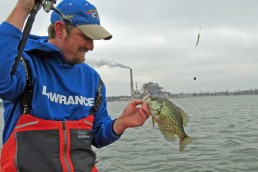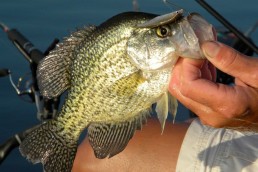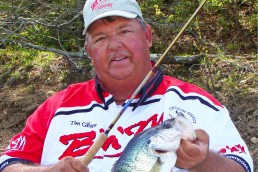Patterning Cooling-plant Lake Black Crappies
SHARE THIS POST
Creeping in and out of the many bays and coves of Lake of Egypt, electronics make it possible to see numerous clusters of black crappies. They are sure to be black crappies because they are 4 to 6 feet down. At this time of year the white crappies on this lake are suspending much deeper in, perhaps 30 feet down.
Lake of Egypt is a cooling lake privately owned by Southern Illinois Power Cooperative and others.
Because this is a cooling lake, there is a steady flow of 52-degree water discharged from the power plant turbines. Warmer water flows down the main lake channel and into these coves, attracting the forage fish. The black crappies move into these areas and congregate in those zones that are most comfortable, as well as providing forage for them. The downwind side of the bays seems to be the most common location for the fish. The water seems to be about 2 degrees warmer than on the main lake—not much, but it seems to make a difference.
Kyle Schoenherr (allseasonsguide@yahoo.com) is a top professional crappie angler, a guide in southern Illinois and a good friend. With the help of his Lowrance down-imaging and side-imaging electronics, he is able to locate fish. The black crappies and whites are about the same length, but the blacks are thicker and consequently weigh a little more. The blacks tend to stage nearer to the surface and the whites are below them. The black crappies are the first to move into the weed beds and the last to move out. They have feeding patterns like bluegills, consuming vegetation.
On Lake of Egypt, Schoenherr finds most of his fish near the dam and on the eastern side, about two-thirds of the way down. The water along here is about 20 to 25 feet deep and holds fish longer.
Kyle prefers to fish without a slip-cork. He uses 16-foot-long poles with minnow rigs, even in deep water. The longer poles show the slightest movement on the tip. It helps with the light-biting black crappies. The longer poles are not for single-pole fishing. In single-pole fishing, the 12-foot pole is his choice as the stiffness of the pole provides a better hook-set.
The rig is a standard crappie-rig with a hook and minnow at the end of the line. About 2 feet above it is a drop line of 10 inches and another hook and minnow attached. We hook the minnows through the lips to give a more “natural” presentation. The hook is a Red Tru Turn number 2 with an off-set shank. The off-set aids in hooking fish through the upper lip, which is better for a solid hook with crappies.
Kyle puts out three poles for each in a spider-rig formation. In open water, Kyle likes to use B’n’M ultralight poles with a rear reel seat. Right when the three poles are in the water the crappies begin to bite. The action is so fast and furious that we cannot get all six poles in the water at the same time.
Are you enjoying this post?
You can be among the first to get the latest info on where to go, what to use and how to use it!
Built like little footballs, the fish are about 5 to 6 inches in length. We do hook larger—about 2 pounds—but they get off the hook before we can get them in the boat.
With temperatures just below freezing, the weather is beginning to get to us as we move to another cove. It is not bad in the bays and coves that are out of the wind, but on the main lake as we travel from one to another, the wind makes things miserable. It is time to take lunch and warm up.
Following lunch, it is back to the water. Most of the fish we find with the scanning equipment are in clusters off of secondary points. In some of the coves there are only single fish marked, while in others we find large groups.
As we head back to the ramp we decide to try one more point where we marked fish this morning. With six lines in the water, some fish hit three of them at the same time. The three fish turned out to be three 2-pound largemouth bass—that is a neat way to wind up the day.
Don Gasaway is a veteran outdoor writer from Marion, Ill. He may be contacted at: dongasaway.wordpress.com or facebook.com/DonsJournal.
For more information…
Information on the lake is at: sipower.org/p/lakeofegypt.php. A map is available at sipower.org/p/map.pdf.
MWO
SHARE THIS POST
Did you enjoy this post?
You can be among the first to get the latest info on where to go, what to use and how to use it!
Don Gasaway
Don Gasaway is a veteran freelance outdoor writer from Marion, Ill. He may also be found at: https://www.facebook.com/DonGasawayWriter and facebook.com/Wandering Angler. Comments are welcome



